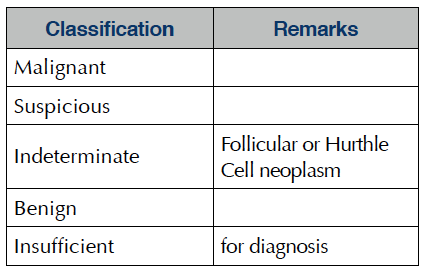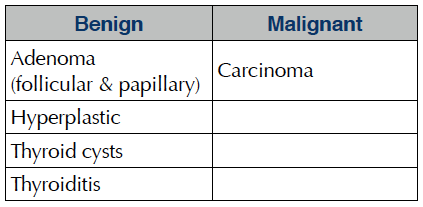My Thyroid has Nodules! What shall I do
Nodular thyroid disorder FAQ
written by Dr James Kong
(Last update on: Oct 28th 2020)
Nodular thyroid disorder is common (5~10%) but solitary nodules in the thyroid are found in 0.22~1.35% among paediatrics and 4.0% in the adult population. The goal in the evaluation of a solitary thyroid nodule is to differentiate true neoplasms from the rest of a multitude of thyroid conditions.
Introduction
The prevalence of thyroid nodules in any population will depend on various factors which include…sex, age, diet, iodine deficiency and also to the likelihood of radiation exposure be it environmental or therapeutic. Thyroid nodules are more common in females and the prevalence increases with age such that 5% of the population aged 60 years will have a thyroid nodule. There is also a direct dose response relation of thyroid nodularity to radiation exposure to the head and neck region (i.e. treatment for acne in early 20th century, and such).
Although thyroid nodules are less common in the paediatric population, the risk of malignancy among these nodules (15~20% of the thyroid nodules) is much higher when compared to the adult. The majority of nodules in children are benign but as thyroid cancer is considered more aggressive among children, accurate and timely diagnosis is critical.
Initial Evaluation
A comprehensive history (of the neck mass, past medical and family) with a careful examination of the head and neck region is important. Symptoms of neck pain, stridor, dysphagia as such increase clinical suspicion but are not diagnostic. Physical characteristics of the neck are also poor predictors of malignancy.
Recent change in size, fixation or invasion of adjacent tissues and presence of palpable lymphadenopathy are suggestive of malignancy. Vocal cord paralysis is not an absolute indicator or malignancy as this can be associated with benign conditions.
Thyroid function tests should be undertaken as routine investigation of a solitary thyroid nodule but this is usually normal in patients with thyroid cancer. Serum thyroglobulin level should not be taken at this stage as benign thyroid conditions can also cause an elevation.
Table 1 Indications for malignant vs benign nodule |
Imaging
The various options available for imaging all have different advantages and disadvantages.
| Table 2 Different modalities of imaging thyroid nodule(s) and neck structures | ||||
| Mode | Pros | Cons | Remarks | |
| Ultrasound | √ √√ | Safe, effective, sizes, differentiates solid vs cystic | Picks up “incidentalomas”!! | Useful to guide FNA |
| Radionuclide | √ | Safe | Inability to 1. delineate nodules clearly 2. differentiate functional status | I [123] and Tc [99m] |
| CT | √ | Useful to assess invasion / compression of trachea, mediastinal masses, recurrent disease | Cannot use iodinated contract agent | Limited role in the initial investigation |
| MRI | ? | N/A | ||
| PET | ? | No indications for routine use | ||
Fine Needle Aspiration Biopsy (FNAB)
This is the initial investigation of choice in view of its accuracy, safety, and cost effectiveness. This procedure is performed (using a fine needle - 23G) as an ambulatory procedure preferably under ultra-sound guidance. The results of FNA cytology should be clearly classified as shown. (Table 3)
In a review of over 28 series of FNAB, the sensitivity (83%), specificity (92%) and accuracy (95%) has been rated well above all other modalities of thyroid investigations. Using larger bore needle may improve the accuracy also increases the risks of haematoma, and injuries to adjacent structures.
Table 3 Classification of FNAB Results |
Evaluation and Management
Following a careful history and clinical examination and fine needle aspiration biopsy of the solitary thyroid an appropriate management plan of observation vs. surgery can be clearly delineated. In patient when the FNAB has indicated a benign pathology, a period of observation using ultrasound is appropriate. Surgery in the form of a thyroidectomy is indicated where the pathology has been confirmed to be malignant.
The choice of thyroid surgery will be addressed in a future paper.
Table 4 Differential Diagnosis of Nodules |
References
1. Basharat R, Bukhari MH, Saeed S, Hamid T. Comparison of fine needle aspiration cytology and thyroid scan in solitary thyroid nodule. Patholog Res Int. 2011;2011:754041. [Medline]. [Full Text].
2. Ashcraft MW, Van Herle AJ. Management of thyroid nodules. I: History and physical examination, blood tests, X-ray tests, and ultrasonography. Head Neck Surg. Jan-Feb 1981;3(3):216-30. [Medline].
3. Blum M, Rothschild M. Improved nonoperative diagnosis of the solitary ‘cold’ thyroid nodule. Surgical selection based on risk factors and three months of suppression. JAMA. Jan 18 1980;243(3):242-5. [Medline].
4. Brennan M. USSR: medical effects of Chernobyl disaster. Lancet. May 5 1990;335(8697):1086. [Medline].
5. Brooks JR. The solitary thyroid nodule. Am J Surg. Apr 1973;125(4):477-81. [Medline].
6. Campbell JP, Pillsbury HC 3rd. Management of the thyroid nodule. Head Neck. Sep-Oct 1989;11(5):414-25. [Medline].
7. Can AS, Peker K. Comparison of palpation-versus ultrasound-guided fine-needle aspiration biopsies in the evaluation of thyroid nodules. BMC Res Notes. May 15 2008;1:12. [Medline].
8. Carlson KM, Bracamontes J, Jackson CE, et al. Parent-of-origin effects in multiple endocrine neoplasia type 2B. Am J Hum Genet. Dec 1994;55(6):1076- 82. [Medline].
9. Cerise EJ, Randall S, Ochsner A. Carcinoma of the thyroid and nontoxic nodular goiter. Surgery. Apr 1952;31(4):552-61. [Medline].
10. Correa P, Chen VW. Endocrine gland cancer. Cancer. Jan 1 1995;75(1 Suppl):338-52. [Medline].
11. De Jong SA, Demeter JG, Castelli M, et al. Follicular cell predominance in the cytologic examination of dominant thyroid nodules indicates a sixty percent incidence of neoplasia. Surgery. Oct 1990;108(4):794- 9; discussion 799-800. [Medline].
12. De Micco C, Vasko V, Garcia S, et al. Fine-needle aspiration of thyroid follicular neoplasm: diagnostic use of thyroid peroxidase immunocytochemistry with monoclonal antibody 47. Surgery. Dec 1994;116(6):1031-5. [Medline].
13. Favus MJ, Schneider AB, Stachura ME, et al. Thyroid cancer occurring as a late consequence of head-and-neck irradiation. Evaluation of 1056 patients. N Engl J Med. May 6 1976;294(19):1019-25. [Medline].
14. Gharib H. Fine-needle aspiration biopsy of thyroid nodules: advantages, limitations, and effect. Mayo Clin Proc. Jan 1994;69(1): 44-9. [Medline].
15. Gibb GK, Pasieka JL. Assessing the need for frozen sections: still a valuable tool in thyroid surgery. Surgery. Dec 1995;118(6): 1005-9; discussion 1009-10. [Medline].
16. Goldfarb M, Gondek S, Solorzano C, Lew JI. Surgeon-performed ultrasound can predict benignity in thyroid nodules. Surgery. Sep 2011;150(3):436-41. [Medline].
17. Grebe SKG, Hay ID. Clinical evaluation of thyroid tumors. In: Thawley SE, Panje WR, Batsakis, eds. Comprehensive Management of Head and Neck Tumors. Philadelphia, Pa: WB Saunders Co; 1999:1694- 1709.
18. Haff RC, Schecter BC, Armstrong RG, et al. Factors increasing the probability of malignancy in thyroid nodules. Am J Surg. Jun 1976;131(6):707-9. [Medline].
19. Hamilton JG, Soley MH. Studies in iodine metabolism by use of a new radioactive isotope of iodine. Am J Physiol. 1939;127:557.
20. La Rosa GL, Belfiore A, Giuffrida D, et al. Evaluation of the fine needle aspiration biopsy in the preoperative selection of cold thyroid nodules. Cancer. Apr 15 1991;67(8):2137-41. [Medline].
21. Ledger GA, Khosla S, Lindor NM, et al. Genetic testing in the diagnosis and management of multiple endocrine neoplasia type II. Ann Intern Med. Jan 15 1995;122(2):118-24. [Medline].
22. Lee RV. The generalist: a jaundiced view. Am J Med. Sep 1983;75(3):381. [Medline].
23. Lips CJ, Landsvater RM, Hoppener JW, et al. Clinical screening as compared with DNA analysis in families with multiple endocrine neoplasia type 2A. N Engl J Med. Sep 29 1994;331(13):828-35. [Medline].
24. Liu Q, Castelli M, Gattuso P, et al. Simultaneous fine-needle aspiration and core-needle biopsy of thyroid nodules. Am Surg. Jul 1995;61(7):628-32; discussion 632-3. [Medline].
25. Maxon HR, Thomas SR, Saenger EL, et al. Ionizing irradiation and the induction of clinically significant disease in the human thyroid gland. Am J Med. Dec 1977;63(6):967-78. [Medline].
26. Mazzaferri EL. Management of a solitary thyroid nodule. N Engl J Med. Feb 25 1993;328(8):553-9. [Medline].
27. Mazzaferri EL, de los Santos ET, Rofagha-Keyhani S. Solitary thyroid nodule: diagnosis and management. Med Clin North Am. Sep 1988;72(5):1177- 211. [Medline].
28. McConahey WM, Hay ID, Woolner LB, et al. Papillary thyroid cancer treated at the Mayo Clinic, 1946 through 1970: initial manifestations, pathologic findings, therapy, and outcome. Mayo Clin Proc. Dec 1986;61(12):978-96. [Medline].
29. Messaris G, Evangelou GN, Tountas C. Incidence of carcinoma in cold nodules of the thyroid gland. Surgery. Sep 1973;74(3):447-8. [Medline].
30. Messaris G, Kyriakou K, Vasilopoulos P, et al. The single thyroid nodule and carcinoma. Br J Surg. Dec 1974;61(12):943-4. [Medline].
31. Mortenson JD, Woolner LB, Bennet WA. Gross and microscopic findings in clinically normal thyroid glands. J Clin Endocrinol Metab. 1955;15:1270- 80.
32. Nikiforov Y, Gnepp DR. Pediatric thyroid cancer after the Chernobyl disaster. Pathomorphologic study of 84 cases (1991-1992) from the Republic of Belarus. Cancer. Jul 15 1994;74(2):748-66. [Medline].
33. Perkel VS, Gail MH, Lubin J, et al. Radiation-induced thyroid neoplasms: evidence for familial susceptibility factors. J Clin Endocrinol Metab. Jun 1988;66(6):1316-22. [Medline].
34. Rallison ML, Dobyns BM, Keating FR Jr, et al. Thyroid nodularity in children. JAMA. Sep 8 1975;233(10):1069-72. [Medline].
35. Refetoff S, Harrison J, Karanfilski BT, et al. Continuing occurrence of thyroid carcinoma after irradiation to the neck in infancy and childhood. N Engl J Med. Jan 23 1975;292(4):171-5. [Medline].
36. Rojeski MT, Gharib H. Nodular thyroid disease. Evaluation and management. N Engl J Med. Aug 15 1985;313(7):428-36. [Medline].
37. Rougier P, Calmettes C, Laplanche A, et al. The values of calcitonin and carcinoembryonic antigen in the treatment and management of nonfamilial medullary thyroid carcinoma. Cancer. Mar 1 1983;51(5):855-62. [Medline].
38. Sampson RJ, Woolner LB, Bahn RC, et al. Occult thyroid carcinoma in Olmsted County, Minnesota: prevalence at autopsy compared with that in Hiroshima and Nagasaki, Japan. Cancer. Dec 1974;34(6):2072-6. [Medline].
39. Sawin CT, Geller A, Wolf PA, et al. Low serum thyrotropin concentrations as a risk factor for atrial fibrillation in older persons. N Engl J Med. Nov 10 1994;331(19):1249-52. [Medline].
40. Scheible W, Leopold GR, Woo VL, et al. High-resolution real-time ultrasonography of thyroid nodules. Radiology. Nov 1979;133(2): 413-7. [Medline].
41. Schneider DL, Barrett-Connor EL, Morton DJ. Thyroid hormone use and bone mineral density in elderly women. Effects of estrogen. JAMA. Apr 27 1994;271(16):1245-9. [Medline].
42. Sharma R, Mondal A, Shankar LR, et al. Differentiation of malignant and benign solitary thyroid nodules using 30- and 120-minute tc-99m MIBI scans. Clin Nucl Med. Sep 2004;29(9):534-7. [Medline].
43. Singer PA. Evaluation and management of the solitary thyroid nodule. Otolaryngol Clin North Am. Aug 1996;29(4):577-91. [Medline].
44. Smith RB, Robinson RA, Hoffman HT, et al. Preoperative FDG-PET imaging to assess the malignant potential of follicular neoplasms of the thyroid. Otolaryngol Head Neck Surg. Jan 2008;138(1):101-6. [Medline].
45. Thomas CG Jr, Buckwalter JA, Staab EV, et al. Evaluation of dominant thyroid masses. Ann Surg. May 1976;183(5):463-9. [Medline].
46. Trowbridge FL, Matovinovic J, McLaren GD, et al. Iodine and goiter in children. Pediatrics. Jul 1975;56(1):82-90. [Medline].
47. Vander JB, Gaston EA, Dawber TR. Significance of solitary nontoxic thyroid nodules; preliminary report. N Engl J Med. Dec 9 1954;251(24):970-3. [Medline].
48. Wells SA Jr, Donis-Keller H. Current perspectives on the diagnosis and management of patients with multiple endocrine neoplasia type 2 syndromes. Endocrinol Metab Clin North Am. Mar 1994;23(1):215-28. [Medline].
49. Wu CW, Dionigi G, Lee KW, Hsiao PJ, Paul Shin MC, Tsai KB, et al. Calcifications in thyroid nodules identified on preoperative computed tomography: Patterns and clinical significance. Surgery. Sep 10 2011;[Medline].
| Copyright ©2017 Asia Medical Specialists Limited. All rights reserved. |

